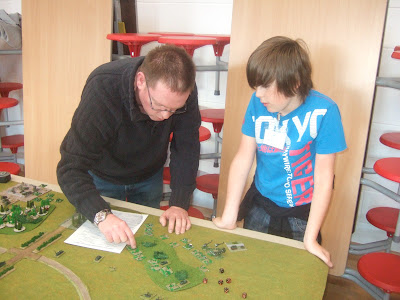At Crisis Point I was struck by the way that some of the other gamers’ 1/300th scale aircraft were firmly attached to their flight stands. It was oddly pleasing to be able to pick up an aircraft by its stand and not have it wobble, spin or fall off. I came home seriously tempted to glue my aircraft to their stands but worried that they’d take up a lot of storage space.
My stands are built with clear plastic rod and previously I've used a Dremel-type tool to grind the plastic to a point like a blunt-ended pencil. This end was then jammed into a hole drilled in the bottom of the aircraft model. Sometimes the result can be good and stable; sometimes it’s not.
 |
| My old style of flight stand |
What follows is the replacement technique I’ve now settled upon. To make your flight stands you’ll need some:
- artist’s mounting board
- clear plastic rod
- epoxy putty (Green Stuff)
- filler (tile grout or Tetrion; I think the Americans call it Spackle)
- Neodymium magnets (I used 4mmx1mm disks from e-magnetsuk.com)
Plus whatever you usually use to make your basing look attractive.
The first thing you need to do is to get one magnet glued to the bottom of one aircraft. Because aircraft tend not to have nice flat undersides (and because most of my existing collection had holes drilled at the balance point) I chose to stick my magnets on with a blob of Green Stuff. This proved to be a very secure means of attachment.
 |
| An F-111 with neodymium magnet attached via a blob of Green Stuff - mostly they stick well with Green Stuff but this one needed reattaching with a little cyanoacrylate after the Green Stuff had set. |
It’s important to do just one aircraft first - the magnets have polarity and if you get your magnets glued in differing polarities, some of your aircraft won’t stick to some of your stands!
Whilst the Green Stuff is setting, cut your artist’s mounting board to the appropriate size. I use 40mm squares.
Then cut your plastic rod to length. I use a variety of lengths from about 30mm to about 100mm. I find the best way to cut the rod is to make a shallow cut right around the circumference with a razor saw. It’ll then snap neatly.
Attach the rod to the centre of the card square with a ball of Milliput or Green Stuff squeezed into a cone shape. You can then build up round the putty with your usual basing material; I use tile grout coloured with brown poster paint.
Next you need to glue your magnets to the top of your new flight stands. This is where the first aircraft comes in. Hold your stack of magnets to the one on the bottom of the plane so the top one latches on. You now know which side of the magnet needs gluing to the flight stand. Carefully pull it apart from the magnet on the aircraft. At this point I mark the surface of the magnet that will be uppermost on the stand with a blob from a black marker pen. Then glue the magnet to the top of the rod with super glue (cyanoacrylate).
Your flight stand is now usable but you’ll probably want to do some terrain modelling on the base. Then you can attach magnets to your remaining aircraft, remembering in each case to use a flight stand to make sure you get your magnets in the right polarity.
 |
| A French Air Force Bloch 174 disturbs a flock of sheep. |













































